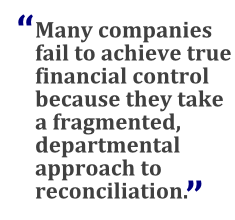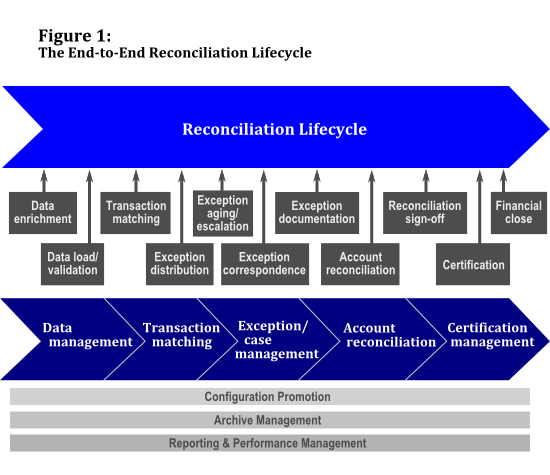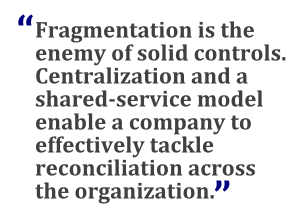 When it comes to increasingoperational efficiency, fragmentation and manual processes are theenemy. Yet many companies fail to achieve true financial controlbecause they take a fragmented, departmental approach toreconciliation that incorporates multiple systems and frequentmanual interventions. Forward-thinking organizations are not onlyautomating reconciliation, but also integrating theirreconciliation and attestation processes to provide a singleversion of the truth based on accurate, real-time,transaction-level data.
When it comes to increasingoperational efficiency, fragmentation and manual processes are theenemy. Yet many companies fail to achieve true financial controlbecause they take a fragmented, departmental approach toreconciliation that incorporates multiple systems and frequentmanual interventions. Forward-thinking organizations are not onlyautomating reconciliation, but also integrating theirreconciliation and attestation processes to provide a singleversion of the truth based on accurate, real-time,transaction-level data.
Large companies process and reconcile millions of transactionsevery day, ranging from accruals and accounting (e.g., accountsreceivable, accounts payable) to cash deposits and bankreconciliations. These same organizations certify, or attestto, thousands of G/L balances each period. Many of thesebalance certifications are based on the detailed transactionreconciliations that the treasury and finance teams complete everyday.
|Fragmented reconciliation systems and processes make itdifficult for finance to accurately track and report on accountinginformation. Any manual work involved in comparing and reconcilingdata between systems not only increases administrative costs, butalso introduces the risk of errors and slows down exceptionmanagement. If a company can't standardize the exception managementprocess, there's a risk of noncompliance with corporate andindustry controls.
|One additional pressing challenge is that many companies performreconciliation checks through systems that rely on onlybalance-level information. This may help companies identify whereexceptions exist—but finding out exactly which transaction causedthe discrepancy, and then driving the issue through to resolution,still require extensive manual research.
|Any data issues that develop during reconciliation becomeexacerbated in the company's attestation processes. Oncetransactions have been stored and reconciled, they are typicallypassed to a stand-alone system that supports both monthly andquarterly certification of the numbers. To import the right datainto the attestation system at the right time, organizationstypically take snapshots of balance-level data from thereconciliation system and other systems in which accounting data isstored. This process often relies on manual tools such asspreadsheets, which further increases administrative workloads,costs, and the risk of errors.
| Even organizations with more sophisticated stand-aloneattestation systems may be exposed to significant risks. This isusually the case when, for example, a company uses acustom-developed attestation system or a non-integrated outsourcedservice from a third-party provider. Extracts of accounting datamay be shared at the file level or may be cut and pasted betweensystems, providing only a static, point-in-time view. In addition,each system that feeds data into the attestation system may show aslightly different version of the balance sheet. This type ofdiscrepancy can lead to internal discussions about which numbersare accurate, which significantly increases workloads andcosts.
Even organizations with more sophisticated stand-aloneattestation systems may be exposed to significant risks. This isusually the case when, for example, a company uses acustom-developed attestation system or a non-integrated outsourcedservice from a third-party provider. Extracts of accounting datamay be shared at the file level or may be cut and pasted betweensystems, providing only a static, point-in-time view. In addition,each system that feeds data into the attestation system may show aslightly different version of the balance sheet. This type ofdiscrepancy can lead to internal discussions about which numbersare accurate, which significantly increases workloads andcosts.
|
Technology for True End-to-EndReconciliation
|To increase efficiency and reduce financial and regulatory risk,many organizations are deploying technologies that bringreconciliation activities together to present the bigger picture.Figure 1, on page 2 of this article, illustrates the range of differentactivities that can be pulled into a single system that offersend-to-end reconciliation.
||These “true” reconciliation solutions bring transaction-leveland balance-level data together in one place, which enables them toprovide detailed information on why exceptions have occurred andhow they can be resolved. True end-to-end reconciliation solutionsprovide:
- Support for the full range of transaction types—includingwires, checks, cards, ACH, SWIFT transfers, and cash, as well assecurities, intercompany transactions, and trades—all in a singlesystem.
- Full automation of the reconciliation lifecycle, from loadingand enhancing data to matching, identifying, and solvingexceptions, through to certifying the accuracy of the balancesheet.
- Integration of balance-level and transaction-level data toincrease visibility into causes of exceptions; eliminate manualinterventions; and provide rapid, cost-effective resolutions.
- Standardization of processes for transparency and visibilityacross all transaction types and scenarios.
- Enforcement of enterprise-wide governance and controls,including the critical period-end close process.
Benefits abound for companies that bring all these activitiesinto a single system. Elimination of manual research orinterventions at any stage of the process enables the company tofree up staff for more value-added work, such as identifying rootcauses of exceptions and trends in the data. It can also bringmajor reductions in per-transaction costs.
|At the same time, end-to-end reconciliation streamlinesaccounting and reporting processes and improves the managementteam's visibility of business performance. Payments made late inthe month, for example, are captured centrally in real time,ensuring that accounts can be closed more quickly and accurately.Meanwhile, a true reconciliation system dramatically reduces therisk of error that arises when people are frequently rekeying dataacross multiple systems.

|
Centralize to Optimize
|Despite the benefits of automation, some companies are dauntedby the idea of stripping out legacy systems and automating a widerange of previously manual administrative tasks. Many organizationshave found that centralizing reconciliation based on a center ofexcellence (COE) or shared-services delivery model can helpkick-start the improvement process. Centralization ofreconciliation processes provides major benefits that mirror thoseof technology-powered process automation. Centralization can reducecosts, liberate staff to spend time on more value-added activities,and provide senior management with better visibility, ascentralization releases information previously held in siloedsystems for a current, accurate view of business performance.
|Before embarking on a shared-services or COE strategy, however,a company needs to look at its current reconciliation systems andprocesses and define exactly what it wants to achieve in thefuture. It should bring together reconciliation specialists fromacross the business to define and clearly state the company'sobjectives in centralizing reconciliation; goals could includeimproving visibility into enterprise controls, adopting sustainablerisk mitigation and compliance practices, reducing processingcosts, and increasing efficiency. Whatever strategic direction theproject team settles on, they must make sure that senior managementis on board. The shift to a centralized model means bringingmultiple reconciliation teams and resources into a single, cohesivefunction. This requires significant reorganization, as well asinvestments in infrastructure and training, so support fromtop-level management is crucial.
| Once the project team has determined the goals andobjectives of the centralization and/or automation initiative, theyneed to establish consistent reconciliation rules and define thoserules using comprehensive process templates. The same group alsoneeds to decide which elements of the process should be included inthe shared-service center or COE. Decisions should be based on adetailed assessment of each element of the process and its valuefor the business.
Once the project team has determined the goals andobjectives of the centralization and/or automation initiative, theyneed to establish consistent reconciliation rules and define thoserules using comprehensive process templates. The same group alsoneeds to decide which elements of the process should be included inthe shared-service center or COE. Decisions should be based on adetailed assessment of each element of the process and its valuefor the business.
One common mistake is to think of the shared-services functionas another siloed department, but this limits its value. Buildingbridges with all departments and keeping the lines of communicationopen are the routes through which the shared-service center canidentify new opportunities for process improvements andcollectively agree on changes that add value for internalcustomers.
|All these decisions lay the groundwork for the drafting of aproject plan. The best approach is a phased implementation, inorder to introduce employees to the new process in stages. Thisenables the project manager to plan for capacity growth over timeand to incrementally invest in skills and technology that willresult in broader benefits. A shared-services approach reducescosts in the long term, but it can increase the short-terminvestment required to bring an automation solution tofruition.
|In planning the phased implementation, the company shouldidentify high-value lines of business—those that are likely to reapbig benefits from automation—and roll out to these groups first,because an early demonstration of value is critical to long-termsuccess across the company. Then, as use of the shared-services orCOE model expands, the project team must make sure to establishclear lines of communication. As the shared-services plan starts togain the trust and support of different business lines, it may beprudent to reinforce that support by demonstrating the value ofshared services back to the business. This can be done byquantifying costs per transaction and return on investment,engaging new areas of the business, and improving service-levelagreements.
|When organizations reach advanced stages of maturity, theshared-services model begins to deliver quantifiable value.Performance measures can be used to effect major processimprovements, and to establish the shared-service function as atrusted adviser and partner to all departments and business linesacross the company. Whether the shared-services function residesinside or outside the organization, a standard charging modelshould be implemented based on per-transaction billing or billingover a specific time period. This makes it possible to quantifyreturn on investment, engage new areas of the business, andincrease adoption for services.
|Fragmentation is the enemy of solid controls—whether it isfragmentation in the reconciliation lifecycle, utilizing differentsolutions for reconciling data and performing the period-end close,or fragmentation in the process itself. Centralization and ashared-service model enable a company to effectively tacklereconciliation across the organization in a consistent, timely, andpredictable manner.
|————————————–
| Eric Werab is director of product portfoliomanagement for Financial Control Solutions at Fiserv. He isresponsible for the strategic direction of the company's suite ofreconciliation and financial control products. In this capacity, heworks with customers across many markets to understand theirinternal-control needs and ensure the Fiserv solutions meet theseneeds.
Eric Werab is director of product portfoliomanagement for Financial Control Solutions at Fiserv. He isresponsible for the strategic direction of the company's suite ofreconciliation and financial control products. In this capacity, heworks with customers across many markets to understand theirinternal-control needs and ensure the Fiserv solutions meet theseneeds.
Complete your profile to continue reading and get FREE access to Treasury & Risk, part of your ALM digital membership.
Your access to unlimited Treasury & Risk content isn’t changing.
Once you are an ALM digital member, you’ll receive:
- Critical Treasury & Risk information including in-depth analysis of treasury and finance best practices, case studies with corporate innovators, informative newsletters, educational webcasts and videos, and resources from industry leaders.
- Exclusive discounts on ALM and Treasury & Risk events.
- Access to other award-winning ALM websites including PropertyCasualty360.com and Law.com.
*May exclude premium content
Already have an account? Sign In
© 2024 ALM Global, LLC, All Rights Reserved. Request academic re-use from www.copyright.com. All other uses, submit a request to [email protected]. For more information visit Asset & Logo Licensing.







